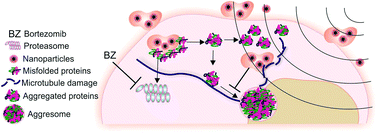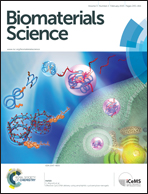Enhanced proteotoxic stress: one of the contributors for hyperthermic potentiation of the proteasome inhibitor bortezomib using magnetic nanoparticles†
Abstract
The induction of hyperthermia using nanoparticles, known as magnetic fluid hyperthermia (MFH) in combination with anti-cancer drugs is an attractive method because of the potential for enhanced anti-cancer effects. Recent studies have shown that cells treated with MFH are more sensitive to the proteasome inhibitor bortezomib (BZ) than cells treated by hot water hyperthermia (HWH) under the same temperature conditions. We hypothesized that enhanced proteotoxic stress, caused by a combination of microtubule damage and an increase in the amount of aggregated proteins, may be partially responsible for this observation. To test this hypothesis MCF-7 cells were exposed to hyperthermic treatment (MFH or HWH) at 43 °C or 45 °C for 30 minutes. Then, aggresome formation and microtubule disruption studies at 30 minutes or 2.5 hours of recovery time were performed to evaluate the progressive effects induced by the two treatments. Cell viability at short and long times was evaluated. Aggresome formation and microtubule disruption results suggested that one of the mechanisms by which MFH enhances BZ cytotoxicity is the formation and subsequent accumulation of aggregated proteins in the cytosol due to the interruption of their transport to the perinuclear area through microtubules. Our data show evidence that MFH induces a more toxic and unmitigated proteotoxic stress than HWH under similar temperature conditions.


 Please wait while we load your content...
Please wait while we load your content...